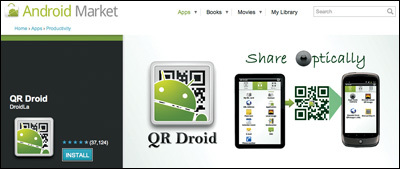From student displays to scavenger hunts, QR codes give class activities a 21st-century twist
From magazines to signs at the local supermarket checkout line, QR codes, those little square boxes of dotted patterns, are everywhere these days. But what purpose do they serve? And what can you do with them in your school?
Quick Response or 2D codes aren’t new technology. I first saw them in the late 1990s when I worked for FedEx. Aiming a scanner at a code, an employee could quickly access information about a package’s weight, origin, and destination. While the codes themselves haven’t changed much, specialized equipment connected to a database is no longer required to read the information in them. All you need is a smartphone with a code reader installed.
 Free QR code readers are available for all of the major smartphone operating systems. The one that I use on my Android device is QR Droid. A quick search in Apple’s App Store reveals plenty of other free readers, the most popular seems to be QR Reader for the iPhone. For users of Blackberry and Windows phones, there’s BeeTagg. Visit the website, select your handset, and download the corresponding reader. Once it’s installed, you can scan any QR code to reveal its content, which could be as simple as a link to a website or something more substantive such as nutritional information while food shopping.
Free QR code readers are available for all of the major smartphone operating systems. The one that I use on my Android device is QR Droid. A quick search in Apple’s App Store reveals plenty of other free readers, the most popular seems to be QR Reader for the iPhone. For users of Blackberry and Windows phones, there’s BeeTagg. Visit the website, select your handset, and download the corresponding reader. Once it’s installed, you can scan any QR code to reveal its content, which could be as simple as a link to a website or something more substantive such as nutritional information while food shopping.
It’s also easy to create your own QR codes. Here, too, you’ll find plenty of free online tools. I’ve been using QR Droid to create QR codes for the past year. To use it, all I have to do is copy and paste the URL of any Web page and click “generate.” QR Droid then creates a code that I can print or post on a Web page. You can also customize the size and color of the code by specifying the pixel dimensions (200 x 200 is the default) and by selecting a color scheme from the drop-down menu.
Other code generators are available from Delivr and Azon Media. Both work in pretty much the same way as QR Droid does. Azon Media also lets you create codes for chunks of text that can be read on a phone without linking to a website. And if you want to track how often your codes are used, Azon Media offers that service, too. The cost ranges from free to $199/month, depending on how many codes you want to track.
Now, to ways that you can use QR codes in school. Posting codes around your library and having students search for and scan them is a fun, active way for kids to become familiar with the media center. In a twist, you could intentionally misplace the QR codes and ask students to relocate them to the correct section of your library. Or how about a QR code scavenger hunt? Russel Tarr, founder of Active History offers a free template for creating codes for these activities that get “students using their mobile devices to move and to learn.”
With QR codes, students can really ramp up a collage display. Take that old collage assignment—you know, those that end up a glue-stick mess—and update it for the current century. Students can illustrate a concept or event with some images and text on a physical poster, yet make even more content available through the use of QR codes. Have students use one of the tools mentioned above to create QR codes that they place in their collages. Create a display of all the collages, then students, armed with their smartphones, can embark on a gallery walk to learn more about each topic.
One final thought. Students might forget to grab their lunch, notebook, and other important items in the morning rush, but they never forget their phone. So have students scan and save digital content to their devices, and they’ll have a portable record of important information. Likewise, I’ve created QR codes for my students of the study guides for the courses I teach this year.


